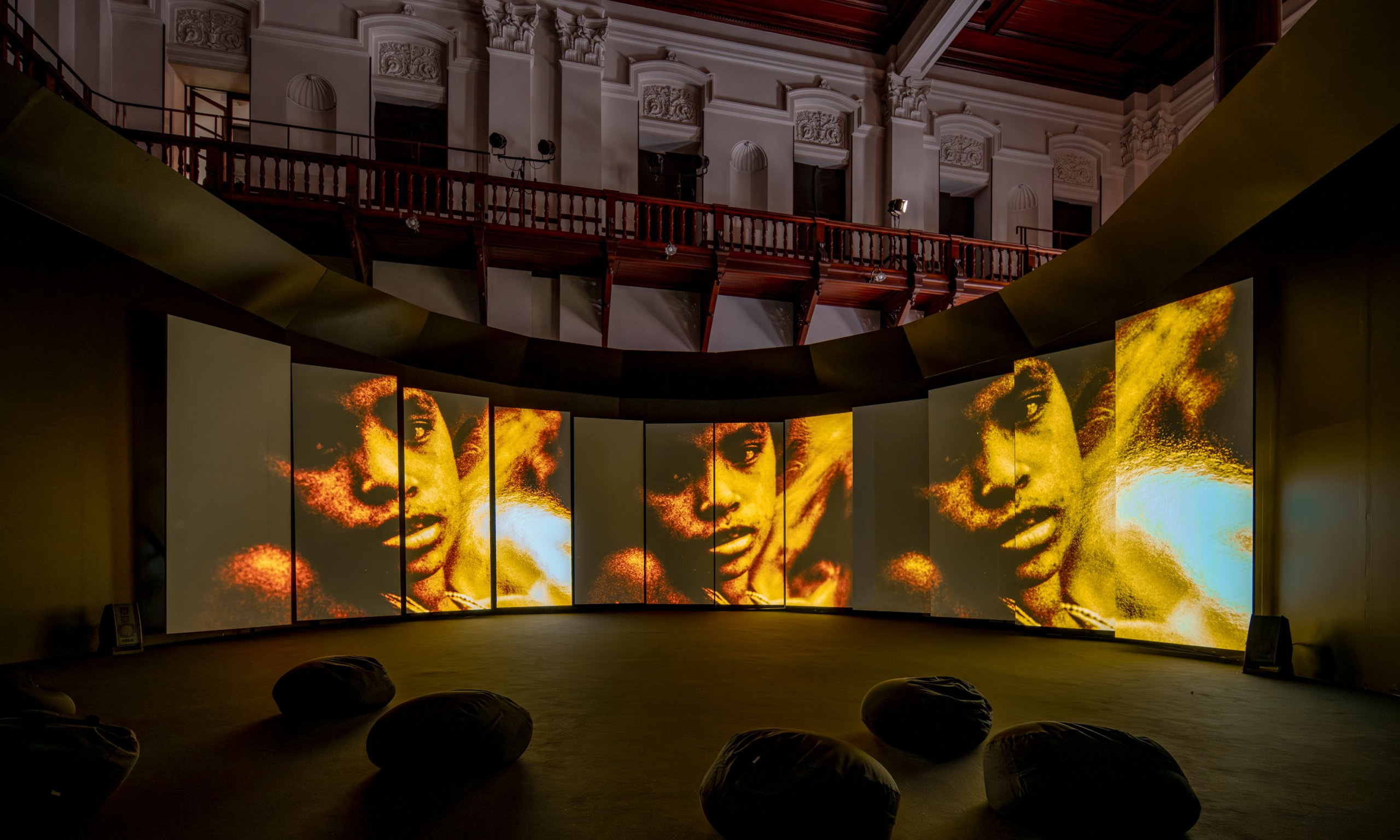An installation of Claudia Andujar: The Yanomami Struggle. With Davi Kopenawa and Yanomami artists
Photo: Kenryou Gu
Kyotographie takes place at a time when the sakura (cherry blossoms) are in full bloom, and the beauty of Kyoto, Japan’s ancient imperial capital, is hard to miss when exploring the photography festival's programme—organised into 13 exhibitions scattered throughout the city. Each venue, from the Kyoto National Museum to a former kimono factory, to a building designed by Tadao Ando, adds to the unique character of the event, which has built a reputation for the emphasis it places on stagecraft and setting.
As the festival’s co-founder Lucille Reyboz points out, this approach is linked to Japanese tradition: “In any Japanese ceremony, from a tea ceremony to a theatrical performance, the journey to reach the moment is as important as the moment itself. It's the same for the presentation of exhibitions: the way visitors are led to engage with a story is crucial.” Some of the programming occupies heritage sites with numerous restrictions, which has, on several occasions in this edition encouraged creative responses from both artists and scenographers.
The photographer Thierry Ardouin, for example, has collaborated with the designer Shinichiro Ogata to adapt his Seed Stories for display in the former kitchens of Nijō Castle. This long-term project, originally conceived as a book (published by Atelier EXB in 2022), is a celebration of the aesthetics of seeds that also addresses some of the history and the cultural, scientific and ecological questions they raise. Ogata has created scenography around the concepts of yin and yang, showing Ardouin’s works on screen angled in such a way as to put them in conversation with the shadow and natural light in the building.
Installation view of Thierry Ardouin. Seed Stories
Photo by Kenryou Gu
A retrospective of work by Viviane Sassen, held at the Maison Européenne de la Photographie in Paris last autumn, is, meanwhile, re-imagined in a former printing house. This concrete space, without any natural light, offers a stark contrast to the private mansion that hosted the original show—and brings the Dutch photographer’s experimentation and pioneering use of colour to the fore in an entirely different way. According to the curator Clothilde Morette, the Parisian exhibition took a more historical approach, while this latest presentation is more focused on the formal aspects of the artist’s work.
Viviane Sassen, Eudocimus Ruber, from the series Of Mud and Lotus (2017)
© Viviane Sassen and Stevenson (Johannesburg / Cape Town / Amsterdam)
Reyboz says that the emphasis on staging and scenography is partly about a desire to address difficult topics in a way that resonates with, and does not come across as too direct for, local audiences. “Everything is possible in Japan, but it all depends on how you package things. Scenographies are essential because they allow us to create a bridge to sensitive subjects. It is thanks to this that the festival was able to function here.”
Among the exhibitions Reyboz picks out with this in mind is Claudia Andujar’s collaboration with the indigenous Yanomami people of Brazil, who have long faced battles against oppression. For Reyboz, their cause resonates with the fate of the Ainu, an indigenous people of Japan’s Hokkaido island. In the show, the visitor weaves between Andujar’s photographs and the testimonies of the Yanomami—expressed through drawings and videos as well as texts from their spokesperson, the shaman Davi Kopenawa—before entering a structure, shaped to reflect Yanomami architecture, where a video installation explores the increasing violence against these people on the part of the Brazilian government.
Claudia Andujar, Susi Korihana thëri au bain, Catrimani, Roraima (1972-74)
© Claudia Andujar
On the other side of Kyoto’s Kamo-gawa River, homage is paid to the struggle of Iranian women for their freedom. Titled You don't die and conceived by the French newspaper Le Monde, this exhibition recounts, image by image, the events following the death of the student Mahsa Amini in September 2022. Amini died in a hospital after being detained by Iran’s morality police for allegedly not complying with the country’s regulations around hijabs.
At the Kyocera Museum of Art, which is taking part in Kyotographie for the first time, is an exhibition supported by the luxury group Kering’s Women in Motion programme, which each year brings together the work of two Japanese photographers from different generations.
There, two very intimate series by Rinko Kawauchi focused on her family are paired with works by Tokuko Ushioda, in what is the latter’s first major exhibition, at the age of 84. Ushioda’s work on view here—from a series of photographs of refrigerators taken over a 20-year period to snapshots of her home—are as humorous as they are poetic.
Installation view of Tokuko Ushioda’s exhibition ICE BOX+My Husband: From Our Windows
Photo: Takeshi Asano
Other exhibitions feature artists who have pushed the boundaries of photography to their limits. There is a show of work by the Chinese duo Birdhead, for example—consisting of Song Tao and Ji Weiyu—who explored the formal and spiritual possibilities of the medium to the extent of imagining a “phototheist” religion. And another dedicated to the Irish photographer Eamonn Doyle, whose multi-screen video and sound installation takes viewers on fragmented journey through the streets of his hometown of Dublin.
Installation view of Welcome to Birdhead World Again, Kyoto 2024
Photo by Takeshi Asano
Finally, Lucien Clergue, the founder of the photography festival Rencontres d'Arles, is honoured in an exhibition featuring his works spanning multiple decades— his photographs focused on Romani communities in Arles in the 1950s among them. It is a double tribute, since Rencontres d'Arles was an inspiration behind the establishment of Kyotographie in 2013.

